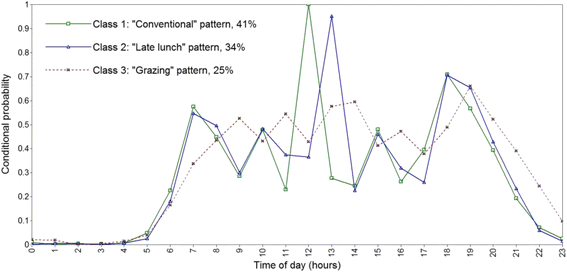Temporal eating patterns: a latent class analysis approach
- PMID: 28061795
- PMCID: PMC5219683
- DOI: 10.1186/s12966-016-0459-6
Temporal eating patterns: a latent class analysis approach
Abstract
Background: There is some evidence that large energy intakes towards the end of the day are associated with adverse health outcomes, however, studies of temporal eating patterns across the day are rare. This study examines the temporal eating patterns of Australian adults using latent class analysis (LCA), as a novel approach.
Methods: Dietary data (n = 2402 men and n = 2840 women, ≥19 years) from two 24-h recalls collected during the 2011-12 Australian National Nutrition and Physical Activity Survey were analyzed. LCA was performed to identify distinct temporal eating patterns based on whether or not an eating occasion (EO) occurred within each hour of the day. F and adjusted-chi2 tests assessed differences in sociodemographic and eating patterns (e.g., meal, snack and EO frequency) between latent classes.
Results: Three patterns, labelled "Conventional" (men: 43%, women: 41%), "Later lunch" (men: 34%, women: 34%) and "Grazing" (men: 23%, women: 25%) were identified. Men and women with a "Grazing" pattern were significantly younger (P < 0.001) and a higher proportion were from major cities (P < 0.01) and were not married (men only, P = 0.01), compared to the "Conventional" and "Later lunch" patterns. The "Grazing" pattern was also characterized by a higher EO frequency (P < 0.01) and snack frequency (P < 0.001) and consumption of a higher proportion of total energy intake from snacks but a lower proportion of total energy intake from meals (P < 0.001).
Conclusions: This study identified three distinct temporal eating patterns in adults that varied by age, EO frequency, snack frequency and energy intake pattern. LCA is a useful approach to capture differences in EO timing across the day. Future research should examine associations between temporal eating patterns and health.
Keywords: Chrono-nutrition; Eating occasion; Eating patterns; Latent class analysis; Meal timing; Meals; Snacks.
Figures


References
-
- Almoosawi S, Vingeliene S, Karagounis LG, Pot GK. Chrono-nutrition: a review of current evidence from observational studies on global trends in time-of-day of energy intake and its association with obesity. Proc Nutr Soc. 2016 - PubMed
MeSH terms
LinkOut - more resources
Full Text Sources
Other Literature Sources
Research Materials

